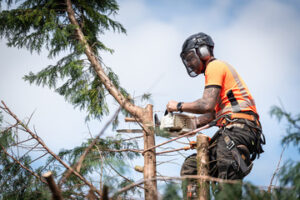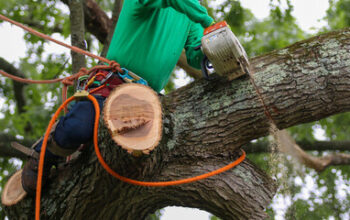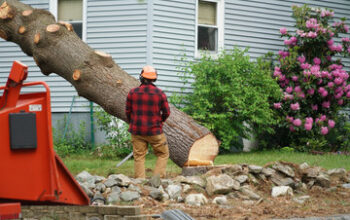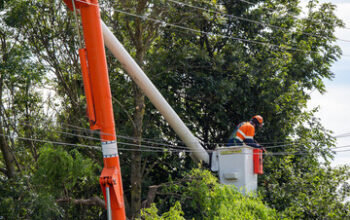Before pruning, you need to have a clear goal. Never remove living branches unless they are dead or damaged. It is also important to prune at the right time of year.
Pruning improves plant health, opens vistas, repairs storm damage, and maintains safety. Common tree trimming goals include: crown thinning, crown raising, removing suckers, and size management cuts. If you encounter any problems, call Tino’s Tree Service.
 Removing Dead Or Damaged Branches
Removing Dead Or Damaged Branches
Removing dead or damaged branches is the first thing you should do when pruning a tree. This can help reduce the risk of injury or property damage, and it will also encourage the growth of healthy, strong new branches. Dead branches are an invitation for pests and diseases to spread throughout the tree, and they can also create fire hazards if they fall or break near a structure.
When removing a dead branch, always start on the underside of the branch, about 18 inches from where you plan to cut it. This will prevent the bark from stripping. Then, cut halfway through the branch. This will remove the bulk of the weight and encourage the formation of callus, which is necessary for proper wound healing. Once you have removed the branch, gently lower it to the ground and dispose of it properly.
If you’re not sure whether a branch is dead, scrape away a small section of bark to see if it’s soft and green underneath. If the branch is alive, it will be softer and greener, but if it’s dead, it will be dry and brown.
Branches that are dead or dying can easily fall during a storm, so it’s important to prune them as soon as possible. In addition, dead branches can cause rot and attract insects and disease. It’s also a good idea to prune the branches of young trees as they are developing so that the tree has a single dominant leader, which will prevent future problems with limbs crossing or rubbing together.
Another reason to prune is to remove unhealthy or broken limbs, such as those that have been damaged by a storm or other natural event. In most cases, it’s best to remove these branches even if they are still alive. This will help to maintain the health of the tree and prevent pests and diseases from infiltrating the body.
There are many different reasons to prune a tree, but it’s important to know the difference between thinning, crown management, and structural cuts before getting started. For example, thinning involves pruning the branches of a tree to allow more light and air to reach the lower canopy. Crown management cuts, on the other hand, shorten a tree’s height or width and can help to correct an overgrown tree.
Reducing The Crown Of The Tree
Using crown reduction to reduce the overall size of a tree’s canopy can be beneficial, particularly in windy areas. It can also improve the health of the tree by allowing more sunlight and decreasing the stress on individual branches during strong storms. It can also help prevent damage to buildings or power lines. When reducing the crown, it is important to work slowly and carefully. Cutting too many branches at once can create a weak spot in the tree, which could lead to serious damage and even death.
Reducing a tree’s crown involves shortening side branches to make the canopy smaller. A professional arborist should be able to determine the ideal branch size for the desired outcome. They will look for lateral branches that are healthy and can carry the terminal growth of the parent branch. Then, they will cut the lateral branch at a point where it is at least one-third of the diameter of the parent branch. This will leave a smaller wound that is less likely to attract pests and disease or allow decay to enter.
This technique should not be confused with topping, which is a pruning practice that removes large portions of the crown of a tree and leaves stubs and lateral branches. Topping can cause severe damage to a tree and is not recommended for most species. It can also increase the need for corrective pruning or crown restoration in the future.
It is recommended that crown reductions be done in winter, which is when trees are essentially dormant. This will minimize the impact on the tree and allow it to recover in the spring. Depending on the circumstances, however, summer trimmings can be beneficial as well.
When cutting branches, it is important to use a sharp tool and to be aware of the location of the stem collar, which is a small lip of bark that each branch grows from. It is crucial to avoid removing this collar, which can lead to rot or disease. It is also important to make the cuts at a downward angle, as this will help to prevent water from settling into the wound and damaging the tree.
Removing Suckers
If a tree is prone to suckering, as lilacs and crabapples are, it may be necessary to remove suckers from time to time to help the plant remain healthy and look its best. However, removing the suckers can be challenging since they grow from the roots or the base of the trunk, and if left unchecked, they will continue to sprout repeatedly. Fortunately, there are several ways to remove them quickly and effectively.
The first step is to identify the suckers and determine whether they are a true graft or not. You can do this by locating the graft union, which is usually a large bump near the ground. Any growth that appears from the ground that is not a part of the graft union should be removed as it will likely not grow into a desirable branch. Using a pair of sharp shears or loppers, cut the suckers at their base close to where they emerge from the soil. Be sure to leave the collar, or small bulge where the sucker meets the mother plant, in place to help the wound heal. After cutting off the suckers, cover them with topsoil or compost to discourage future growth.
Once the suckers are removed, it’s important to keep up with regular pruning. This will prevent the suckers from growing and reduce the amount of stress on the tree. It’s also important to use a sharp pair of shears to make the cuts as clean as possible, which will help promote a healthy wound and encourage the tree to heal more quickly.
Ideally, suckers should be removed as soon as they appear to prevent them from growing too large and becoming a threat to the health of the tree. If they are left to grow too long, they will compete with the desired branch and rob the tree of energy that could be better spent growing fruit or flowers. If you are unable to stop the suckers from growing, it may be helpful to add an anti-sucker spray to your gardening tool kit so that you can quickly and easily remove them when they appear.
Reducing The Height Of The Tree
Trimming and pruning can help keep trees healthy and attractive. It can also prevent damage to your home, yard, or power lines. It can even encourage new growth and help reduce the risk of disease or storm damage. But it’s important to know the different types of trimming and pruning techniques before you get started.
For example, reducing the height of a tree involves removing branches that are extending too close to the ground or causing obstructions. This is often done to provide clearance for mowing, power lines, or walkways. It can also reduce the potential risk of failure from a heavy load or a wind-induced failure. However, this type of pruning should only be conducted when it is necessary. It can leave gaps that could become a breeding site for pests or diseases.
Another type of pruning is thinning, which removes branches from the canopy of a tree to reduce its density and allow more sunlight to reach the ground. It is a very common practice for fruit and shade trees. This process can be very dangerous, so it’s important to hire a professional when it comes to thinning your trees.
When a branch is removed from a tree, it forms a callus on the remaining bark. This callus helps to protect the tree from insects and fungi that could cause decay. To avoid damaging the bark, it’s important to make the first cut on the underside of the limb and then move up about 18 inches. This will enable you to make a second cut that is higher up on the limb.
The third cut should be made at the limb’s branch bark ridge. This ensures that no wood stub is left and also promotes controlled healthy new growth. In addition, the final cut should be oriented toward the direction you want the branch to grow.
Other types of trimming include crown reduction, which shortens the overall size of a tree, and pollarding, which removes the entire head of a small tree to give it a more pleasing form. It’s important to prune your trees regularly and to use the proper techniques when doing so.



